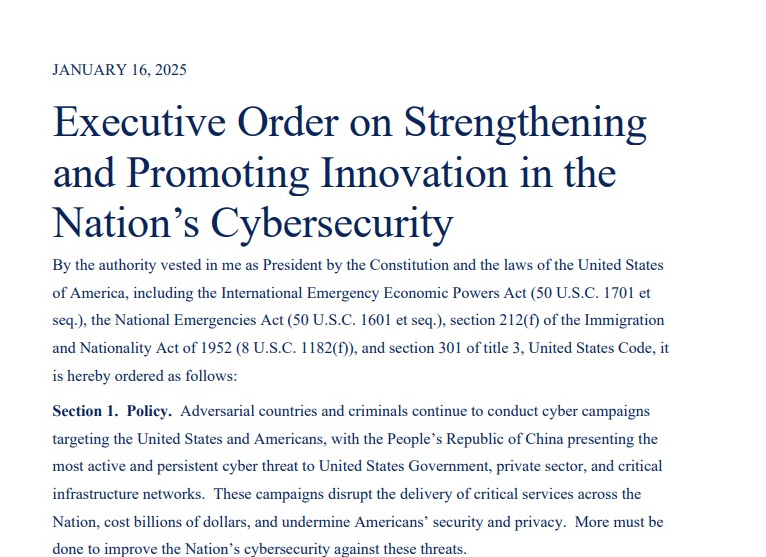Trump's Cybersecurity Executive Order: Policy Shifts and Strategic Implications

Executive Summary
On June 6, 2025, President Trump issued a transformative Executive Order that fundamentally reshapes federal cybersecurity policy by amending Executive Orders 13694 (Obama) and 14144 (Biden). The order represents a strategic pivot from the Biden administration's approach, narrowing federal mandates while maintaining focus on critical infrastructure protection against foreign threats.
Bottom Line Up Front: Organizations must accelerate their independent cybersecurity capabilities as federal oversight contracts and key government cybersecurity expertise diminishes, while preparing for stricter software supply chain requirements and quantum-resistant technologies by 2025-2030.

Key Policy Changes Analysis
1. Sanctions Authority Narrowed to Foreign Actors Only
What Changed: EO 13694 amendments now specify sanctions apply only to "any foreign person" rather than "any person", reflecting what the administration calls preventing "misuse against domestic political opponents."
Strategic Impact: This change signals a shift toward external threat focus while potentially reducing domestic cybersecurity enforcement capabilities. Organizations should expect reduced federal oversight of domestic cybersecurity violations but increased scrutiny of foreign supplier relationships.

2. Digital Identity Framework Eliminated
What Was Removed: The Biden EO's digital identity directives that encouraged federal agencies to accept digital identity documents and helped states develop secure mobile driver's licenses were completely eliminated.
Administration Rationale: The White House claimed these initiatives "risked widespread abuse by enabling illegal immigrants to improperly access public benefits", though cybersecurity experts note the original policies contained no such mandates.
Business Impact: Organizations lose federal leadership on digital identity standards, increasing fraud vulnerability. Identity theft contributed to up to $135 billion in unemployment fraud during the pandemic, making this rollback particularly concerning for fraud prevention efforts.
3. AI Cybersecurity Programs Dramatically Scaled Back
Eliminated Initiatives:
- Federal red teaming requirements for AI systems
- Energy sector AI pilot programs for cyber defense
- Pentagon requirements to "use advanced AI models for cyber defense"
- Federal research prioritization for AI-powered coding security
What Remains: Agencies must incorporate AI software vulnerabilities into existing vulnerability management processes, but the proactive AI defense research framework has been dismantled.
4. Software Supply Chain Requirements: Mixed Signals
Removed Requirements:
- Federal contractors no longer required to submit secure software development attestations to CISA
- Eliminated centralized validation of software attestations by CISA
- No longer required in machine-readable format
New Approach: NIST must establish a consortium with industry by August 1, 2025, to develop guidance based on NIST Special Publication 800-218 (Secure Software Development Framework)
Timeline Impact: Secure software rules still target 2025 implementation, but through industry collaboration rather than federal mandate.
5. Core Technical Requirements Maintained
Preserved Mandates:
- Border Gateway Protocol (BGP) security to defeat network hijacking
- Post-quantum cryptography protection against next-generation compute threats
- Latest encryption protocols adoption
- US Cyber Trust Mark labeling requirement for consumer IoT products by January 4, 2027
6. Federal Agency Capabilities Under Pressure
Budget and Staffing Crisis: CISA faces proposed cuts from 3,732 to 2,649 positions in fiscal 2026, while NIST has lost key cybersecurity experts including Matthew Scholl, chief of the Computer Security Division.
Operational Impact: "NIST's greatest asset is its scientists. To lose this many all at the same time is going to be a massive hit" according to former officials. The proposed cuts could trigger a "brain drain" across partner universities.
Critical Deadlines and Requirements
Immediate (2025)
- August 1, 2025: NIST consortium establishment with industry for secure software guidance
- August 14, 2025: DNS resolver encryption requirements for federal government
- September 2, 2025: NIST SP 800-53 updates for secure patching guidance
- December 1, 2025: Preliminary SSDF framework update
Medium-term (2026-2027)
- January 16, 2026: FAR Council deadline for IoT labeling amendments
- January 4, 2027: US Cyber Trust Mark requirement effective for federal contractors
- March 31, 2026: Final SSDF framework update
Long-term (2030)
- January 2, 2030: Transport Layer Security protocol version 1.3 or successor required for federal systems
Strategic Implications for Organizations
1. Accelerated Self-Reliance Requirements
With reduced federal guidance and oversight, organizations must:
- Audit software pipelines immediately - Federal attestation requirements may return in modified form
- Map encryption and cryptographic posture - Post-quantum transition remains mandatory
- Harden BGP routes - Network infrastructure requirements maintained
- Implement independent AI red-teaming - Federal programs eliminated but risks remain
2. Supply Chain Vulnerability Exposure
- Vendor assessment intensification needed as federal oversight contracts
- Foreign supplier scrutiny increases under narrowed sanctions framework
- Documentation standards may shift as industry consortium develops new guidance
3. Identity and Access Management (IAM) Criticality
- Reinforce IAM systems as federal digital identity leadership disappears
- Independent fraud prevention capabilities become essential
- Multi-factor authentication acceleration needed without federal pilots
4. Resource Competition Challenges
- "NIST employees anticipate having to do less with less"
- Private sector talent war intensifies as government experts leave
- Industry consortium participation becomes critical for standards influence
Risk Assessment
High-Risk Scenarios
- Standards fragmentation as federal coordination weakens
- Capability gaps in AI threat detection without federal research
- Fraud acceleration without digital identity framework
- Technical debt accumulation in quantum transition preparation
Mitigation Strategies
- Proactive industry engagement in NIST consortium development
- Independent AI security capabilities development
- Enhanced due diligence on foreign technology suppliers
- Accelerated quantum-resistant cryptography implementation
Hard Questions for Your Organization
Technical Readiness
- Are your software development pipelines audit-ready? Changes in attestation requirements likely but timing uncertain
- Can your routing infrastructure withstand BGP attacks? Federal mandates maintained with reduced support
- Is your encryption strategy quantum-resistant? 2030 deadline approaching with fewer federal resources
Strategic Positioning
- Who owns cybersecurity standards development in your industry? Federal leadership contracting creates vacuum
- What's your exposure in vendor supply chains? Foreign actor sanctions narrowed but enforcement unpredictable
- How do you replace federal AI security guidance? Research programs eliminated but threats growing
Operational Capacity
- Can you compete for cybersecurity talent? Government "brain drain" increases private sector competition
- Do you have independent threat intelligence capabilities? CISA threat hunting contracts reportedly ending
- Are you prepared for reduced federal cybersecurity partnership? Budget cuts limit agency engagement capacity
Conclusion
This Executive Order represents the most significant cybersecurity policy shift since the Obama administration, fundamentally altering the federal government's role from active oversight to industry collaboration. While core technical requirements remain, organizations face increased responsibility for independent cybersecurity capabilities as federal expertise and resources contract.
The executive orders signal the floor of cybersecurity requirements. Your organization still owns the ceiling.
Organizations that proactively strengthen their cybersecurity posture, engage in industry consortium development, and prepare for reduced federal partnership will be best positioned to navigate this new landscape. Those waiting for federal guidance may find themselves vulnerable as adversaries exploit the transition period.







